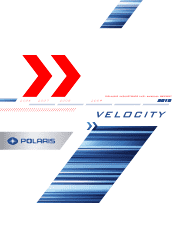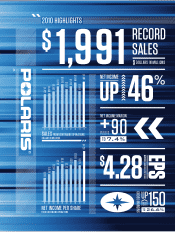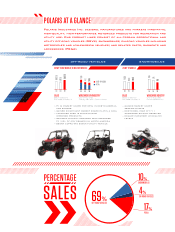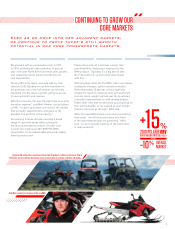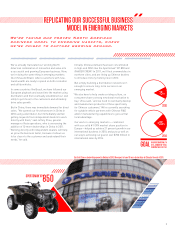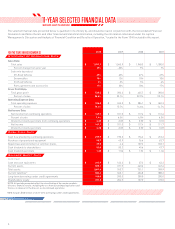Polaris 2010 Annual Report Download - page 8
Download and view the complete annual report
Please find page 8 of the 2010 Polaris annual report below. You can navigate through the pages in the report by either clicking on the pages listed below, or by using the keyword search tool below to find specific information within the annual report.
4
It isn’t enough to have the industry’s most innovative
products. We have to get those products to customers
faster and more cost effectively than anyone else.
A few years ago, we began modifying our manufac-
turing facilities to give us more flexibility, which
allows us to reduce lead times and production
costs — and fundamentally improve how our
powersports vehicles are delivered.
To further improve that capability, we’re concen-
trating our manufacturing in three centers of
excellence — Roseau, Minnesota, Spirit Lake, Iowa,
and a new facility in Monterrey, Mexico (expected
to open in mid-2011), that is closer to growing
demand in the southern United States and Latin
America. While the shift required us to make one
of the most difficult management decisions in
Polaris’ 56-year history — to close and eventually
sell our Osceola, Wisconsin, facility after 19 years
of operation — the move was necessary to make us
more globally competitive.
The key benefit of our manufacturing flexibility
is higher customer satisfaction with less waste,
resulting in higher profits for both us and dealers.
“When Polaris told us we’d be able to order every two
weeks versus every six months, we were skeptical
they could deliver, but they did,” said Matt Kiel, a
15-year Polaris dealer who owns Arizona West
Allsports Inc. in Lake Havasu City. He was referring
to our Max Velocity Program, known as MVP, which
has transformed the retail experience at all our
North American ORV dealerships.
“Now, instead of pulling our best people away from
customers for an extended period of time to try and
guess what to order,” Kiel explained, “I sit down
with a Polaris rep for less than an hour every two
weeks, and we discuss the order based on real sales
and demand.“
The benefits of MVP, he said, include better diversity
of product line for customers, increased sales and
increased value in the Polaris brand, “because we
no longer need to discount the product to unload
excess inventory.” Thanks partially to MVP, North
American dealer inventory for all products combined
is down 20 percent from 2009 levels, and about
50 percent lower than four years ago.
Getting to market faster not only drives retail sales,
it also allows us to test new ideas — like the Polaris
BREEZE™ Neighborhood Electric Vehicle — more cost
effectively than competitors.
“
Matt Kiel, president of Arizona West Allsports Inc. in Lake Havasu City, has seen the benefits of MVP.
I hired two more employees and did
with Polaris this year.
$1 MILLION MORE
”
-10%
0807
-5%
09
-24%
-20%
10
FUNDAMENTALLY RESTRUCTURING
THE RETAIL EXPERIENCE
NORTH AMERICAN POLARIS
DEALER INVENTORY LEVELS

